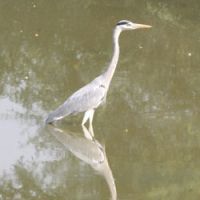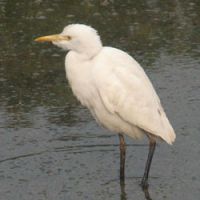Late afternoon sunlight was slanting low, glinting like liquid gold, reflecting in the narrow strip of water between broad expanses of snow.
A bugling flight of swans planed down on bowed wings, their white plumage appearing somehow creamy against the snowy backdrop as they dropped in to their roost at Osatsu-numa, here in Hokkaido.
Skeins and V formations of greater white-fronted geese were passing overhead like black chevrons cut from the wintry sky, while out on the broad expanse of snow beside the narrow open water, a group of Bean geese looked so dark and two-dimensional that they appeared to have been etched in the whiteness.
It was as if, somehow, they had been lifted from the winter season to expose a different, darker layer, hinting at Spring beneath.
Yet more Bean geese arrived, all deeply honking their greetings; they glided in on arched wings, their feet spread as air-brakes, and landed with a flurry of beats and an excited chattering of calls.
Their arrival stimulated several pairs to break into a throaty chorus; these greetings and encounters are serious matters, when mates bolster each other's confidence by together picking on other pairs and scolding them — even chasing and pecking them in the heat of the moment.
With their necks extended forward and low, waving sinuously from side to side just above the snow, as they honked and gaggled, to me they appeared as if in a comic tableau.
It's mid March, and though winter lingers up here, hints and signs of Spring are everywhere — in bird behavior, the appearance of catkins and buds on trees, and the condition of the snow.
The snow on the slopes of the world-renowned ski resort of Niseko is already unusually springlike (like mashed potatoes!) and is already prompting regulars to draw comparisons with Golden Week conditions.
In the foreground of the shallow lagoon at Osatsu-numa, elegant white shapes, long-legged and long-necked, were standing along the ice edge, like delicate white origami sculptures leaning into the breeze. Silent and unmoving, they seemed serious, even imperious, their pale eyes peering over long beaks. First one, then three more craned their necks, unfurled their feathers and took flight — their white wings against the late afternoon sky resembling birds in a child's drawing — white Ms against a golden sky. They soon dropped in again, taking up identical poses along the water's edge — their necks stretched, their long, daggerlike beaks poised like athletes readying javelins.
Whereas in flight they had seemed softly white against the sky, now — standing along the interface between flowing water, ice and snow — their sharply angled poses somehow made me think of brittle glass, as ready to snap as their reflections.
In all, I counted more than a dozen egrets, and despite seeing them for several winters now, they still seem out of place to me. I recall when the arrival of any of the white egrets in Hokkaido was a cause of great excitement, a sign of late-Spring migrants in May having overshot their breeding grounds in northern Honshu. But now the eastern great egret, like the hardy grey heron before it, has found that milder months from Autumn to Spring allow it to overwinter well north of its past range. They seem incongruous surrounded by ice in Hokkaido, yet only a matter of some two weeks earlier, I had watched their cousins further south in Honshu and Kyushu and considered them quite at home there.
Japan's wetlands, estuaries, rivers, lakes, marshes and wet agricultural fields support a wide range of members of the heron and egret families — no fewer than 18 species, from the diminutive white little egret to the large white eastern great egret; from the small, dark striated heron to the large grey heron. Some, such as the yellow bittern, are summer visitors; some, such as the purple heron and cinnamon bittern, are restricted in range just to the southwesternmost islands of Japan.
Others are widespread and likely to be encountered almost anywhere south of Hokkaido, such as the black-crowned night heron and the ubiquitous little egret. Small, white and with their feet seemingly having been dipped in yellow paint, little egrets are the more diminutive and sharper-beaked cousins of the eastern great egret. Little egrets, too, have been finding a warmer Hokkaido more to their liking, and each year I can now expect to bump into them several times between May and November. I miss them in winter; perhaps most of them still leave for milder areas to the south, but there can be little doubt that it will only be a matter of time before they also choose to overwinter in the north.
Diversity of food
You may well wonder how it is that so many members of the same family can coexist in one country.
With a wider range of species in the warmer south, diversity of food is the clue. Each species has different tastes: some forage only at night, or choose dusk and dawn for their main activity, while others are strictly diurnal. Those that occur together tend to forage on somewhat different prey or in different ways. By such means the various species can avoid competing directly with each other. Nevertheless, it is not uncommon to find as many as four or even five species together at the same estuary or mud flat.
Although separating an eastern great egret from an intermediate egret, a cattle egret or a little egret takes little training, it does take a sharp eye to tease out the differences in their foraging behavior and in their prey selection.
Cattle egrets are often found foraging in drier areas, around stock animals or following behind a plowing tractor or a harvester, but little and eastern great egrets are commonly encountered at the same time of day in the same habitat — along riversides and on estuaries.
Watch more carefully, though, and you'll notice that they employ somewhat different methods. Eastern great egrets are often to be encountered standing, still and statuelike in quite deep water patiently waiting for prey to swim past them. Otherwise they pace slowly and deliberately, peering intently forward and downward ready to spear their prey in a flash.
The little egret, in contrast, seems more highly strung, a little neurotic; prone to dashing and lunging, it will as likely take several sudden paces then lunge at seemingly invisible prey alongside the water's edge, or pace quickly through shallow water snapping left and right at small prey. In the first instance it is probably taking a common intertidal organism — a slater, or wharf roach — while in the second instance it may be snapping at tadpoles, froglings or at shoals of small fish.
While their behavior is fascinating, you may also notice at this time of the year that your local white egrets are sporting the most delicate of plumes from their chests and on their backs — like fine lace. These, too, are signs of the season — just like the appearance of the plum, peach and then cherry blossoms — and they indicate that these birds are readying themselves for an imminent breeding season.
For our southern egrets, nesting may already have begun, while for those I encountered recently in Hokkaido, nesting may be some weeks away yet. Nevertheless, the signs are here — Spring is several weeks early this year.
Mark Brazil is a naturalist and author with a fascination for life in all its forms and the questions that it raises. He leads naturalists around the world for Zegrahm and Eco-Expeditions. His first book, "A Birdwatcher's Guide to Japan," is now out of print, and highly collectible — but the author has some mint-condition signed copies available for sale. Anyone interested in a personally dedicated copy should contact him at [email protected]





